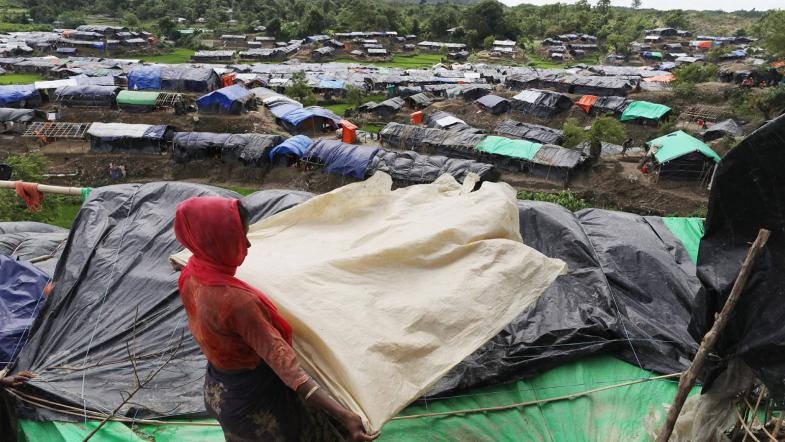
By Lemuel V. Sapian
On March 12, 2018, Yanghee Lee, the Special Rapporteur on human rights in Myanmar for the United Nations told the UN Human Rights Council in Geneva that, “I am becoming more convinced that the crimes committed following 9 October 2016 and 25 August 2017 bear the hallmarks of genocide and call in the strongest terms for accountability.”
Since August 2017 more than 680,000 Rohingya Muslim refugees fled from Myanmar to Bangladesh, and have told stories of mass murder and destruction by the military.[1]
You won’t find many references to the Rohingya people in mainstream media these days, but they are considered one of the most persecuted people in the world and have been so for a while[2]. Therefore, it behooves all lovers of freedom and opponents of persecution to get to know this ethnic group and its plight.
The term “Rohingya” likely comes from the word “Rohang,” a Muslim name for the ancient Kingdom of Arakan.[1][3] Their racial makeup is mostly Indian, but in their earliest days in the 9th century, they intermarried with Arab traders and merchants. To this day the majority of Rohingya identify as Muslim, although a significant minority are Hindu.
Through the centuries the Rohingya were conquered by Muslim and Buddhist Kingdoms, often facing fierce persecution. Near the end of the 18th century, many Rohingya fled their homeland to seek protection under the British Raj because of atrocities committed against them by the Bamar, the dominant ethnic group that comprises today’s Myanmar.[4] The Rohingya returned to Burma during the later part of British colonial rule, and the Burmese reacted harshly.
During World War II there was significant friction between the Muslim and Buddhist communities in Burma. The former supported the British, while the latter tended to support Japanese Imperial rule.[5] When the Japanese conquered Burma, the Buddhist factions joined the Japanese Army in committing mass atrocities against the predominantly Muslim Rohingya.[6]
Unfortunately, while the Rohingya were granted ethnical status after the British granted Burma independence, the Burmese military Junta which rules the nation in 1962 deprived them of many of their political rights. In 1982, Burma enacted a citizenship law which deliberately excluded the Rohingya from a list of ethnic groups recognized by the government as deserving citizenship. As a result, a blind eye is turned when the Burmese violate the rights of the Rohingya and often participate in the injustices.[7]
Little has changed today. Many atrocities have been committed upon the Rohingya by the Myanmar government. This persecution has been considered an act of ethnic cleansing, leaving thousands dead, and many more thousands displaced.[8] Thousands of Rohingya risk life and limb to flee Myanmar to countries like Bangladesh and more recently Thailand, which often treats them with as much contempt as their former Burmese neighbors.
The root of the persecution is nationalism and Buddhist religious zealotry. The predominantly Muslim Rohingya were subject to murder, torture and rape over many decades. The atrocities were justified by the Burmese government labeling them a dangerous terrorist group, sanctioning any act to deprive them of their rights.
In addition to the physical abuses they suffer, the Rohingya are denied access to healthcare, education, and employment because of their status of non-citizens and illegal aliens. They are denied the right to worship freely, and their places of devotion are often vandalized and even destroyed. Their marriages are heavily restricted, and government officials can block any marriage for any reason, or no reason.[9]
Last year the British government halted their training program with the Burmese military over allegations of Burmese military atrocities against the Rohingya.[10] Despite the international pressure and the fact that she won the Nobel Peace Prize in 1990, active Head of State Aung San Suu Kyi continues to downplay the oppression of the Rohingya. She has received international criticism for her mostly silent stance on the issue, especially since she had undergone political oppression before she came to power.
There is no easy solution to the problem, and Christians in First World America, for example, can easily take our privileges for granted. Or perhaps, God forbid, the indifference is because the victims of this persecution have different religious beliefs than we do. By our silence, we can lend tacit support to atrocity merely because we do not agree with the religious convictions of the oppressed. Those who believe in religious liberty and freedom of conscience must act.
We must lend our voices and pens to the support of those whose liberties are curtailed regardless of their background or beliefs so that we fulfill the Biblical mandate which calls us to “do unto others as you would have done unto you.”
[1] Bard Wilkinson, “UN official convinced of Myanmar Rohinga ‘genocide,’” CNN, March 12, 2018. <https://www.cnn.com/2018/03/12/asia/myanmar-rohingya-un-violence-genocide-intl/index.html> Accessed 18 March 2018.
[2] Lennart Hofman, “Meet the Most Persecuted People in the World”, The Correspondent, 25 February, 2016. <https://thecorrespondent.com/4087/meet-the-most-persecuted-people-in-the-world/293299468-71e6cf33> Accessed 13 March 2018.
[3] Abū al-Faz̤l ʻIzzatī; A. Ezzati (2002). The Spread of Islam: The Contributing Factors. ICAS Press. p. 482.
[4] Aye Chan (2005). “The Development of a Muslim Enclave in Arakan (Rakhine) State of Burma (Myanmar)”. SOAS Bulletin of Burma Research, pg. 398-399.
[6] Jonassohn, Kurt (1999). Genocide and gross human rights violations: in comparative perspective. Transaction Publishers. p. 263.
[7] Head, Jonathan (5 February 2009). “What drive the Rohingya to sea?”. BBC. <http://news.bbc.co.uk/2/hi/asia-pacific/7872635.stm> Accessed 13 March 2018.
[8] “Who Are the Rohingya?” Radio Free Asia. <https://www.rfa.org/english/multimedia/rohingyaPage-04122010151733.html/RohingyaFactSheet-04132010102750.html> Accessed 13 March 2018.
[9] Engy Abdelkade. “The history of the persecution of Myanmar’s Rohingya”. The Conversation. < https://theconversation.com/the-history-of-the-persecution-of-myanmars-rohingya-84040 > Accessed 14 March 2018.
[10] Rowena Mason and Heather Stewart. “UK to suspend training of Burmese military over treatment of Rohingya”. The Guardian. 19 September 2017. < https://www.theguardian.com/world/2017/sep/19/uk-suspend-training-burmese-military-treatment-rohingya > Accessed 14 March 2018.
Lemuel V. Sapian earned his BA in History from the University of North Texas. He and his family reside near Denton, Texas.
Photo: Tortured Rohingyas escaped from Myanmar to Bangladesh. Photo Saiful Islam. Creative Commons. Public Domain.